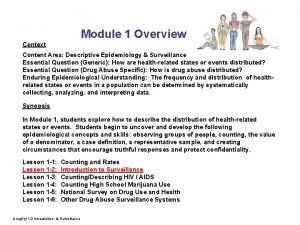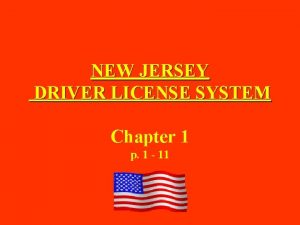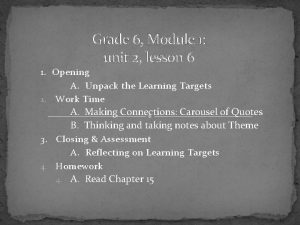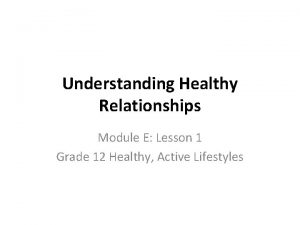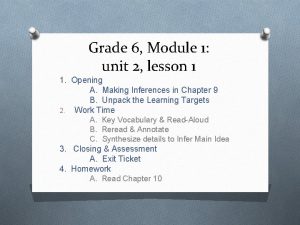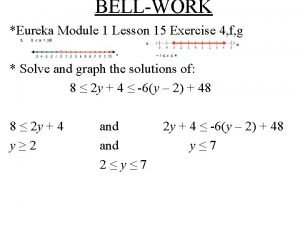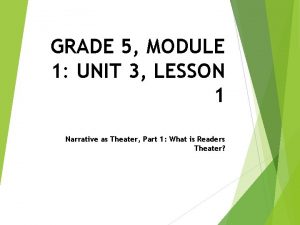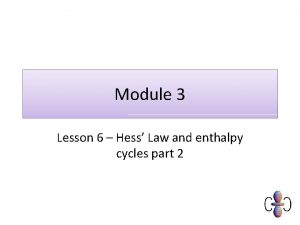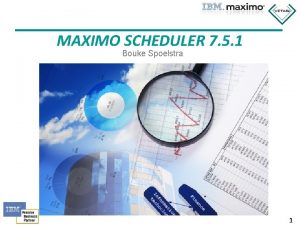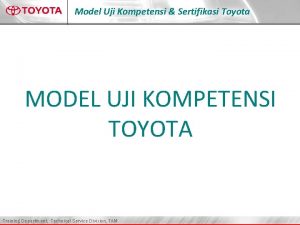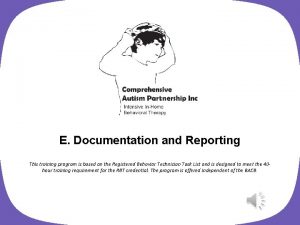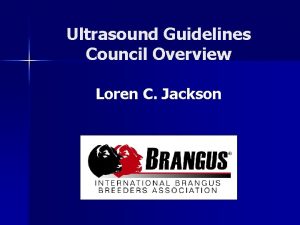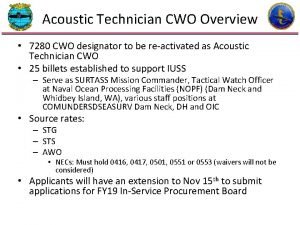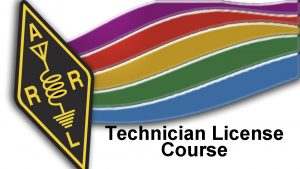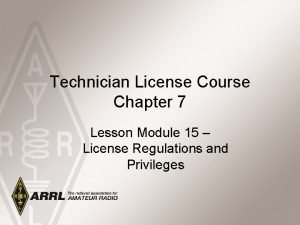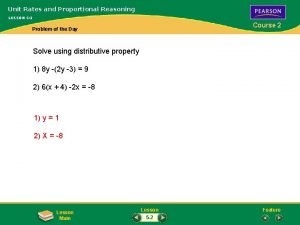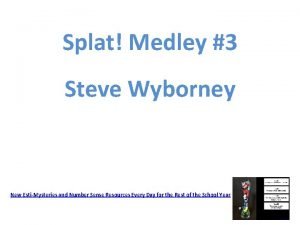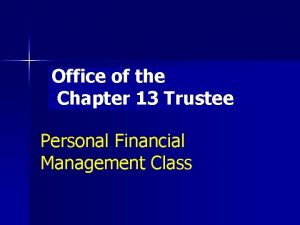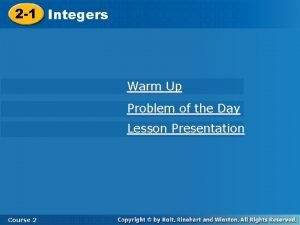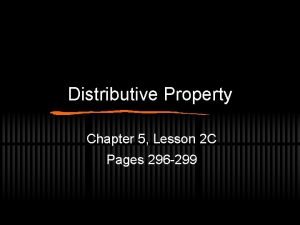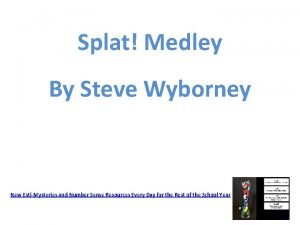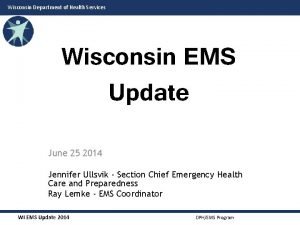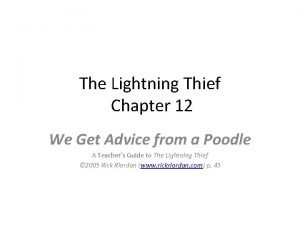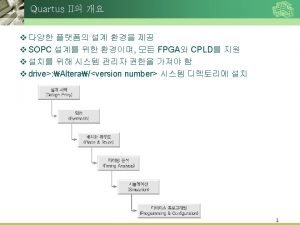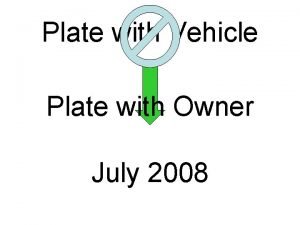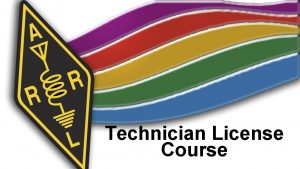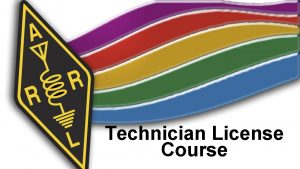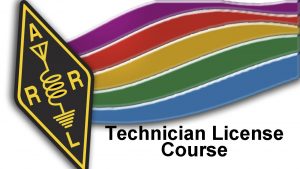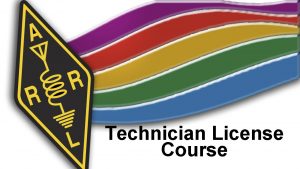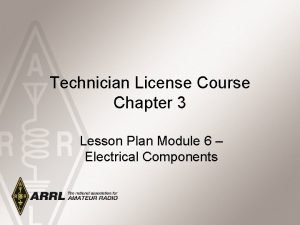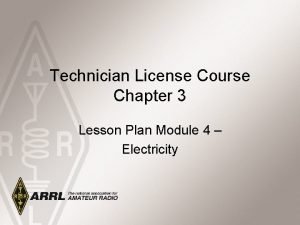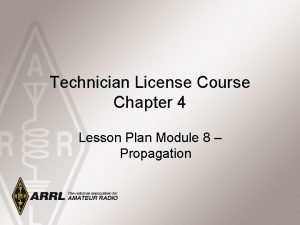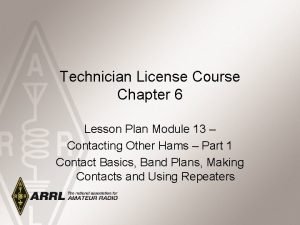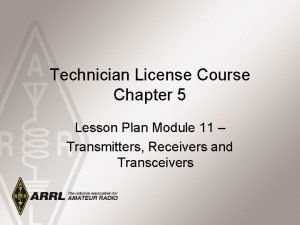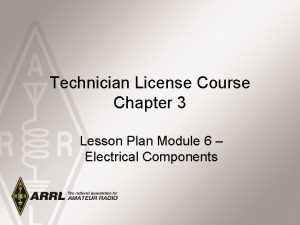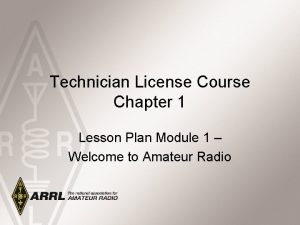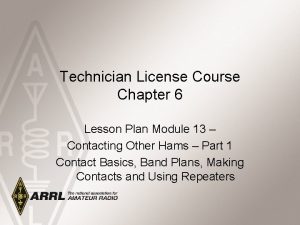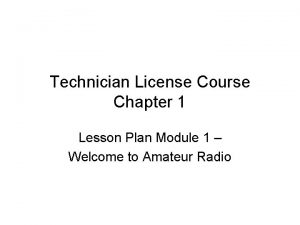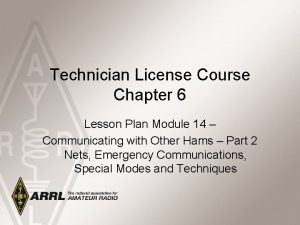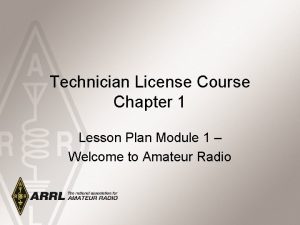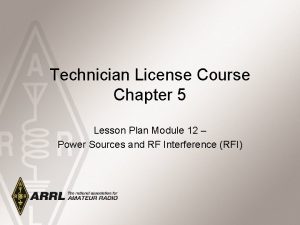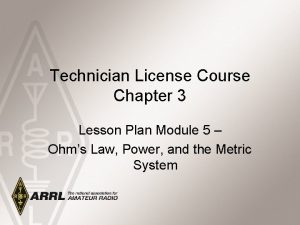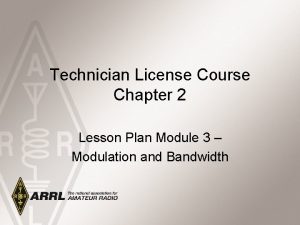Technician License Course Chapter 2 Lesson Plan Module













































































- Slides: 77

Technician License Course Chapter 2 Lesson Plan Module 2 – Radio Signals and Waves

The Basic Radio Station

What Happens During Radio Communication? • Transmitting (sending a signal): – Information (voice, data, video, commands, etc. ) is converted to electronic form. – The information in electronic form is attached or embedded on a radio wave (a carrier). – The radio wave is sent out from the station antenna into space.

What Happens During Radio Communication? • Receiving end: – The radio wave (carrier) with the information is intercepted by the receiving station antenna. – The receiver extracts the information from the carrier wave. – The information is then presented to the user in a format that can be understood (sound, picture, words on a computer screen, response to a command).

What Happens During Radio Communication? • This sounds pretty simple, but it in reality is pretty complex. • This complexity is one thing that makes ham radio fun…learning all about how radios work. • Don’t be intimidated. You will be required to only know the basics, but you can learn as much about the “art and science” of radio as you want.

Radio Waves are AC • Radio waves (electromagnetic radiation) are ac waves. • Radio waves are used to carry the information you want to convey to someone else. • Radio waves travel at the speed of light.

Wave Vocabulary • Before we study radio waves, we need to learn some wave vocabulary. – – – Amplitude Frequency Period Wavelength Harmonics

Now for a Powerful Demonstration • What happens when you drop a magnet through a non-conductive pipe? • What happens when you drop a magnet through a non-ferrous conductive pipe? • The magnet is slowed as it falls through the conductive pipe.

How Radio Waves Travel You have just witnessed in a way how radio waves travel. 1. Moving electrons in the antenna create a magnetic field. 2. This changing magnetic field creates an electric field. 3. Then back and forth between magnetic and electric fields from point A to point B.

Electromagnetic Waves

Finding Where You are on the Radio Dial • There are two ways to tell someone where to meet you on the radio dial (spectrum). – Band (Approximate Wavelength in Meters) – Frequency (Hertz = Cycles per Second)

Radio Frequency (RF) Spectrum • The RF spectrum is the range of wave frequencies which will leave an antenna and travel through space. • The RF spectrum is divided into segments of frequencies that basically have unique behavior.

Wavelength • The distance a radio wave travels during one cycle. – One complete change between magnetic and electric fields. – l = 300 / f (MHz)

Radio Frequency (RF) Spectrum Lower Frequencies = Longer Wavelengths Higher Frequencies = Shorter Wavelengths

What is the name for the distance a radio wave travels during one complete cycle? (T 3 B 01) • • A. B. C. D. Wave speed Waveform Wavelength Wave spread

What is the name for the distance a radio wave travels during one complete cycle? (T 3 B 01) • • A. B. C. D. Wave speed Waveform Wavelength Wave spread

How fast does a radio wave travel through free space? (T 3 B 04) • A. At the speed of light • B. At the speed of sound • C. Its speed is inversely proportional to its wavelength • D. Its speed increases as the frequency increases

How fast does a radio wave travel through free space? T 3 B 04) • A. At the speed of light • B. At the speed of sound • C. Its speed is inversely proportional to its wavelength • D. Its speed increases as the frequency increases

How does the wavelength of a radio wave relate to its frequency? (T 3 B 05) • A. The wavelength gets longer as the frequency increases • B. The wavelength gets shorter as the frequency increases • C. There is no relationship between wavelength and frequency • D. The wavelength depends on the bandwidth of the signal

How does the wavelength of a radio wave relate to its frequency? (T 3 B 05) • A. The wavelength gets longer as the frequency increases • B. The wavelength gets shorter as the frequency increases • C. There is no relationship between wavelength and frequency • D. The wavelength depends on the bandwidth of the signal

What is the formula for converting frequency to wavelength in meters? (T 3 B 06) • A. Wavelength in meters equals frequency in hertz multiplied by 300 • B. Wavelength in meters equals frequency in hertz divided by 300 • C. Wavelength in meters equals frequency in megahertz divided by 300 • D. Wavelength in meters equals 300 divided by frequency in megahertz

What is the formula for converting frequency to wavelength in meters? (T 3 B 06) • A. Wavelength in meters equals frequency in hertz multiplied by 300 • B. Wavelength in meters equals frequency in hertz divided by 300 • C. Wavelength in meters equals frequency in megahertz divided by 300 • D. Wavelength in meters equals 300 divided by frequency in megahertz

What property of radio waves is often used to identify the different frequency bands? (T 3 B 07) • A. The approximate wavelength • B. The magnetic intensity of waves • C. The time it takes for waves to travel one mile • D. The voltage standing wave ratio of waves

What property of radio waves is often used to identify the different frequency bands? (T 3 B 07) • A. The approximate wavelength • B. The magnetic intensity of waves • C. The time it takes for waves to travel one mile • D. The voltage standing wave ratio of waves

What are the frequency limits of the VHF spectrum? (T 3 B 08) • • A. B. C. D. 30 to 300 k. Hz 30 to 300 MHz 300 to 3000 k. Hz 300 to 3000 MHz

What are the frequency limits of the VHF spectrum? (T 3 B 08) • • A. B. C. D. 30 to 300 k. Hz 30 to 300 MHz 300 to 3000 k. Hz 300 to 3000 MHz

What are the frequency limits of the UHF spectrum? (T 3 B 09) • • A. B. C. D. 30 to 300 k. Hz 30 to 300 MHz 300 to 3000 k. Hz 300 to 3000 MHz

What are the frequency limits of the UHF spectrum? (T 3 B 09) • • A. B. C. D. 30 to 300 k. Hz 30 to 300 MHz 300 to 3000 k. Hz 300 to 3000 MHz

What frequency range is referred to as HF? (T 3 B 10) • • A. B. C. D. 300 to 3000 MHz 30 to 300 MHz 3 to 30 MHz 300 to 3000 k. Hz

What frequency range is referred to as HF? (T 3 B 10) • • A. B. C. D. 300 to 3000 MHz 30 to 300 MHz 3 to 30 MHz 300 to 3000 k. Hz

What is the approximate velocity of a radio wave as it travels through free space? (T 3 B 11) • • A. B. C. D. 3000 kilometers per second 300, 000 miles per hour 186, 000 miles per hour

What is the approximate velocity of a radio wave as it travels through free space? (T 3 B 11) A. • B. • C. • D. 3000 kilometers per second 300, 000 miles per hour 186, 000 miles per hour

What is the unit of frequency? (T 5 C 05) • • A. B. C. D. Hertz Henry Farad Telsa

What is the unit of frequency? (T 5 C 05) • • A. B. C. D. Hertz Henry Farad Telsa

What is the abbreviation that refers to radio frequency signals of all types? (T 5 C 06) • • A. B. C. D. AF HF RF VHF

What is the abbreviation that refers to radio frequency signals of all types? (T 5 C 06) • • A. B. C. D. AF HF RF VHF

So, Where Am I? • Back to how to tell where you are in the spectrum. • Bands identify the segment of the spectrum where you will operate. – Wavelength is used to identify the band. • Frequencies identify specifically where you are within the band.

Another Use for Frequency and Wavelength • For the station antenna to efficiently send the radio wave out into space, the antenna must be designed for the specific operating frequency. – The antenna length needs to closely match the wavelength of the frequency to be used. – Any mismatch between antenna length and frequency wavelength will result in radio frequency energy being reflected back to the transmitter, not going (being emitted) into space.

Adding Information - Modulation • When we imprint some information on the radio wave, we modulate the wave. – Turn the wave on and off – Voice -- AM and FM – Data • Different modulation techniques are called modes.

CW - Morse Code – On and Off

Amplitude Modulation (AM) • In AM, the amplitude of the carrier wave is modified in step with the waveform of the information (voice).

Characteristics of Voice AM AM signals consist of three components: – Carrier – Lower sideband – Upper sideband • Voice bandwidth is from 300 Hz to 3 k. Hz. • AM bandwidth is twice the voice bandwidth.

Characteristics of Voice • Sound waves that make up your voice are a complex mixture of multiple frequencies. • When this complex mixture is embedded on a carrier, two sidebands are created that are mirror images.

Single Sideband Modulation (SSB) • Since voice is made up of identical mirror image sidebands: • We can improve efficiency of transmission by transmitting only one sideband then reconstruct the missing sideband at the receiver.

Single Sideband Modulation (SSB) • Single Sideband signals are narrower than standard AM signals and more power efficient. • SSB is the preferred voice mode for weak signals on most bands. • LSB on 160, 80, 40 M • USB on all others (60, 20, 15, 10, 6 and above. )

Frequency Modulation (FM) • Instead of varying the carrier’s amplitude, if we vary the frequency in step with the information waveform – FM is produced. • FM signals are much more resistant to the effects of noise but require more bandwidth. • FM bandwidth (for voice) is between 5 and 15 k. Hz. The higher the modulation level, the more bandwidth (deviation) level.

Frequency Modulation (FM) • FM is only used on frequencies above 28 MHz, because it has a wider bandwidth than AM , SSB, or CW. • FM is used for most voice and data communications in the VHF and UFH bands, including communications involving using repeaters.

Signal Bandwidth • • • CW About 150 Hz SSB Voice Between 2. 5 and 3 k. Hz Slow Scan TVAbout 2. 8 k. Hz AM Voice About 6 k. Hz FM Voice Between 5 and 15 k. Hz Standard TV About 6 MHz (NTSC –Fast Scan)

• Is a good operating practice to be careful near frequency band allocation edges. – You need to be sure that your transmission and side bands remain within the allocated frequency band. – A transmitter’s frequency display may be out of calibration. – A transmitter may drift off frequency.

Why should you not set your transmit frequency to be exactly at the edge of an amateur band or sub-band? (T 1 B 09) • A. To allow for calibration error in the transmitter frequency display • B. So that modulation sidebands do not extend beyond the band edge • C. To allow for transmitter frequency drift • D. All of these choices are correct

Why should you not set your transmit frequency to be exactly at the edge of an amateur band or sub-band? (T 1 B 09) • A. To allow for calibration error in the transmitter frequency display • B. So that modulation sidebands do not extend beyond the band edge • C. To allow for transmitter frequency drift • D. All of these choices are correct

What determines the amount of deviation of an FM signal? (T 2 B 05) • A. Both the frequency and amplitude of the modulating signal • B. The frequency of the modulating signal • C. The amplitude of the modulating signal • D. The relative phase of the modulating signal and the carrier

What determines the amount of deviation of an FM signal? (T 2 B 05) • A. Both the frequency and amplitude of the modulating signal • B. The frequency of the modulating signal • C. The amplitude of the modulating signal • D. The relative phase of the modulating signal and the carrier

What happens when the deviation of an FM transmitter is increased? (T 2 B 06) • A. Its signal occupies more bandwidth • B. Its output power increases • C. Its output power and bandwidth increases • D. Asymmetric modulation occurs

What happens when the deviation of an FM transmitter is increased? (T 2 B 06) • A. Its signal occupies more bandwidth • B. Its output power increases • C. Its output power and bandwidth increases • D. Asymmetric modulation occurs

Which of the following is a form of amplitude modulation? (T 8 A 01) • • A. B. C. D. Spread-spectrum Packet radio Single sideband Phase shift keying

Which of the following is a form of amplitude modulation? (T 8 A 01) • • A. B. C. D. Spread-spectrum Packet radio Single sideband Phase shift keying

What type of modulation is most commonly used for VHF packet radio transmission? (T 8 A 02) • • A. B. C. D. FM SSB AM Spread Spectrum

What type of modulation is most commonly used for VHF packet radio transmission? (T 8 A 02) • • A. B. C. D. FM SSB AM Spread Spectrum

Which type of voice modulation is most often used for long-distance or weak signal contacts on the VHF and UHF bands? (T 8 A 03) • • A. B. C. D. FM FM SSB PM

Which type of voice modulation is most often used for long-distance or weak signal contacts on the VHF and UHF bands? (T 8 A 03) • • A. B. C. D. FM FM SSB PM

Which type of modulation is most commonly used for VHF and UHF voice repeaters? (T 8 A 04) • • A. B. C. D. AM SSB PSK FM

Which type of modulation is most commonly used for VHF and UHF voice repeaters? (T 8 A 04) • • A. B. C. D. AM SSB PSK FM

Which of the following types of emission has the narrowest bandwidth? (T 8 A 05) • • A. B. C. D. FM voice SSB voice CW Slow-scan TV

Which of the following types of emission has the narrowest bandwidth? (T 8 A 05) • • A. B. C. D. FM voice SSB voice CW Slow-scan TV

Which sideband is normally used for 10 meter HF, VHF and UHF single-sideband communications? (T 8 A 06) • • A. B. C. D. Upper sideband Lower sideband Suppressed sideband Inverted sideband

Which sideband is normally used for 10 meter HF, VHF and UHF single-sideband communications? (T 8 A 06) • • A. B. C. D. Upper sideband Lower sideband Suppressed sideband Inverted sideband

What is the primary advantage of single sideband over FM for voice transmissions? (T 8 A 07) • A. SSB signals are easier to tune • B. SSB signals are less susceptible to interference • C. SSB signals have narrower bandwidth • D. All of the choices are correct

What is the primary advantage of single sideband over FM for voice transmissions? (T 8 A 07) • A. SSB signals are easier to tune • B. SSB signals are less susceptible to interference • C. SSB signals have narrower bandwidth • D. All of the choices are correct

What is the approximate bandwidth of a single sideband voice signal? (T 8 A 08) • • A. B. C. D. 1 k. Hz 3 k. Hz 6 k. Hz 15 k. Hz

What is the approximate bandwidth of a single sideband voice signal? (T 8 A 08) • • A. B. C. D. 1 k. Hz 3 k. Hz 6 k. Hz 15 k. Hz

What is the approximate bandwidth of a VHF repeater FM phone signal? (T 8 A 09) • • A. B. C. D. Less than 500 Hz About 150 k. Hz Between 5 and 15 k. Hz Between 50 and 125 k. Hz

What is the approximate bandwidth of a VHF repeater FM phone signal? (T 8 A 09) • • A. B. C. D. Less than 500 Hz About 150 k. Hz Between 5 and 15 k. Hz Between 50 and 125 k. Hz

What is the typical bandwidth of analog fastscan TV transmissions on the 70 cm band? (T 8 A 10) • • A. B. C. D. More than 10 MHz About 6 MHz About 3 MHz About 1 MHz

What is the typical bandwidth of analog fastscan TV transmissions on the 70 cm band? (T 8 A 10) • • A. B. C. D. More than 10 MHz About 6 MHz About 3 MHz About 1 MHz

What is the approximate maximum bandwidth required to transmit a CW signal? (T 8 A 11) • • A. B. C. D. 2. 4 k. Hz 150 Hz 1000 Hz 15 k. Hz

What is the approximate maximum bandwidth required to transmit a CW signal? (T 8 A 11) • • A. B. C. D. 2. 4 k. Hz 150 Hz 1000 Hz 15 k. Hz
 Manufacturing technician license
Manufacturing technician license Manufacturing technician license
Manufacturing technician license Micro teach lesson plan example
Micro teach lesson plan example C device module module 1
C device module module 1 Situational frontline leadership
Situational frontline leadership Course module sample
Course module sample Ravi got milk for the kitten from
Ravi got milk for the kitten from T junction in english bond
T junction in english bond Course number and title
Course number and title Chaine parallèle muscle
Chaine parallèle muscle Getting a driver license illegally may result in
Getting a driver license illegally may result in Chapter 1 the new jersey driver license system answers
Chapter 1 the new jersey driver license system answers Chapter 1 the new jersey driver license system answers
Chapter 1 the new jersey driver license system answers Lesson 1 your total health
Lesson 1 your total health Chapter 7 lesson 3 a new plan of government
Chapter 7 lesson 3 a new plan of government Hardship and suffering during the depression
Hardship and suffering during the depression Module 5 lesson 5
Module 5 lesson 5 Grade 8 module 1 unit 1 lesson 6 answer key
Grade 8 module 1 unit 1 lesson 6 answer key Practical/logistical issues in relationships examples
Practical/logistical issues in relationships examples Grade 6 module
Grade 6 module Module eleven lesson one self check quiz
Module eleven lesson one self check quiz Eureka math algebra 1 module 1 lesson 15
Eureka math algebra 1 module 1 lesson 15 Grade 5 module 1 lesson 1
Grade 5 module 1 lesson 1 Intersecting chords
Intersecting chords Enthalpy of formation hess law
Enthalpy of formation hess law When preparing an iv solution a technician should work
When preparing an iv solution a technician should work How long must a technician evacuating refrigerant
How long must a technician evacuating refrigerant Vet tech pros and cons
Vet tech pros and cons Maximo oil and gas scheduler
Maximo oil and gas scheduler Calibration technician certification
Calibration technician certification 5 healthcare career pathways
5 healthcare career pathways Radar and sonar technician career cluster
Radar and sonar technician career cluster Technician a says that the bulb trade number
Technician a says that the bulb trade number Toyota technician certification
Toyota technician certification Mobile technician app
Mobile technician app Mtm pharmacy technician
Mtm pharmacy technician Maximo technician scheduling
Maximo technician scheduling Rbt session note example
Rbt session note example Surface repair technician
Surface repair technician Safety health and environment apprenticeship
Safety health and environment apprenticeship Translator
Translator Live technician
Live technician Ultrasound guidelines council
Ultrasound guidelines council Bcs coding and logic exam
Bcs coding and logic exam A csi lab technician _____.
A csi lab technician _____. Horticultural technician apprentice
Horticultural technician apprentice Acoustic warrant officer
Acoustic warrant officer Special effects technician
Special effects technician How to become a weatherization technician
How to become a weatherization technician Level 9 technician
Level 9 technician Technician class privileges
Technician class privileges Tracemp
Tracemp Pci wind turbine technician
Pci wind turbine technician Cec pharmacy
Cec pharmacy Ophthalmic technician skills checklist
Ophthalmic technician skills checklist Technician a says that a hoist can be stopped
Technician a says that a hoist can be stopped Ecc x ray technician
Ecc x ray technician Dental technician association of bc
Dental technician association of bc Course plan ppt
Course plan ppt Course 2 chapter 1 ratios and proportional reasoning
Course 2 chapter 1 ratios and proportional reasoning Steve wyborney splat
Steve wyborney splat Chapter 13 personal financial management course
Chapter 13 personal financial management course Integers warm up
Integers warm up Course 2 chapter 5 expressions
Course 2 chapter 5 expressions Estimysteries
Estimysteries Work based learning license mn
Work based learning license mn Wi ems elicensing
Wi ems elicensing Cssm cisco
Cssm cisco Why does grover want a searcher’s license?
Why does grover want a searcher’s license? Ga coam master license for sale
Ga coam master license for sale Tbote license
Tbote license Ingram micro spla
Ingram micro spla Quartus web edition download
Quartus web edition download Michigan raffle license
Michigan raffle license South dakota seller's permit
South dakota seller's permit Nurse practice act oregon
Nurse practice act oregon Ommaverify
Ommaverify Nj 6 points of identification
Nj 6 points of identification





